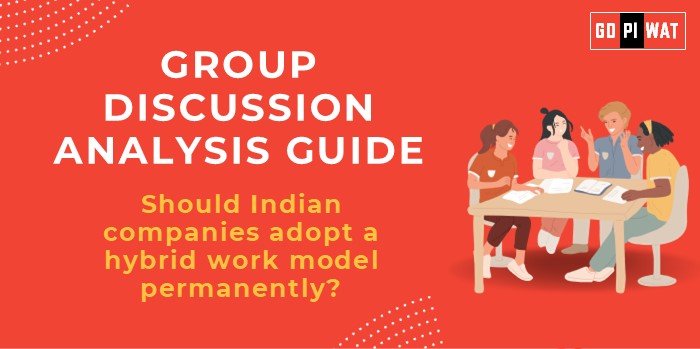📋 Group Discussion (GD) Analysis Guide
🌟 Should Indian companies adopt a hybrid work model permanently?
🌐 Introduction to the Hybrid Work Model
- Opening Context: “The global pandemic has redefined workplace culture, pushing companies to embrace hybrid work models that blend remote and in-office work. For Indian companies, this shift raises a critical question: Should this model become a permanent fixture in corporate strategy?”
- Topic Background: The hybrid work model gained prominence post-2020 as companies adapted to pandemic-induced lockdowns. Globally, organizations like Google, Microsoft, and TCS have explored hybrid frameworks to enhance flexibility and productivity. In India, where a diverse workforce spans metropolitan and rural regions, hybrid work opens doors to talent accessibility, reduced operational costs, and improved employee well-being.
📊 Quick Facts and Key Statistics
- 🌟 72% of Indian employees prefer hybrid work: Showcases its rising acceptance (Microsoft Work Trend Index, 2023).
- 💻 Indian IT sector leads adoption: 90% of top firms operate in hybrid mode (NASSCOM, 2023).
- 📈 Productivity gains: 83% of Indian employees report improved productivity under flexible models (PwC Survey, 2023).
- 🌐 Infrastructure challenges: Only 34% rural households have stable internet connectivity, limiting nationwide implementation (TRAI, 2023).
👥 Stakeholders and Their Roles
- Corporate Organizations: Balance productivity, costs, and employee preferences while adapting to long-term hybrid work policies.
- Government Bodies: Enhance digital infrastructure to support remote work in underserved regions.
- Employees: Seek flexibility and work-life balance while managing hybrid work demands.
- Technology Providers: Offer tools and platforms for seamless collaboration and communication.
- HR Leaders: Redefine workplace policies, engagement models, and productivity metrics.
🏆 Achievements and Challenges
🌟 Achievements
- Higher Productivity: Flexible work environments improve focus and efficiency.
- Cost Savings: Companies reduce operational costs by cutting office maintenance and travel expenses.
- Employee Retention: Hybrid models foster satisfaction and work-life balance, reducing attrition rates.
- Access to Talent: Geographic barriers are removed, allowing companies to hire top talent across India.
⚠️ Challenges
- Digital Divide: Limited access to reliable internet, especially in rural areas.
- Work-Life Balance Blur: Employees struggle to separate professional and personal lives.
- Collaboration Issues: Hybrid work can hamper teamwork, innovation, and communication.
🌍 Global Comparisons
- USA: Companies like Microsoft and Google successfully implemented hybrid work, reporting a 30% reduction in office expenses.
- Singapore: Government investments in digital infrastructure make hybrid work seamless across industries.
📚 Case Study
TCS Hybrid Model Success: TCS implemented a “25×25” model where only 25% of its workforce will work from offices by 2025, maintaining 90% productivity levels while reducing operational costs.
🗣️ Structured Arguments for Discussion
- Supporting Stance: “A hybrid work model enhances employee productivity, reduces overhead costs, and ensures access to a wider talent pool, making it an ideal solution for Indian companies.”
- Opposing Stance: “Indian companies face significant challenges, including the digital divide and reduced collaboration, which make permanent hybrid work unsustainable.”
- Balanced Perspective: “While hybrid work models benefit companies and employees, India’s success depends on addressing infrastructure gaps and developing effective policies to balance flexibility with productivity.”
🎯 Effective Discussion Approaches
🌟 Opening Approaches
- Data-Driven Start: “With 72% of Indian employees favoring hybrid work, it is clear that flexibility has become a cornerstone of modern corporate culture.”
- Contrast Introduction: “While hybrid work promotes flexibility, poor internet connectivity in rural India poses significant hurdles for equitable implementation.”
⚡ Counter-Argument Handling
Challenge: “Hybrid work reduces collaboration.”
Response: “Collaboration tools like Zoom and Teams enable virtual teamwork, supplemented by occasional in-person meetings for brainstorming sessions.”
🔍 Strategic Analysis of Strengths and Weaknesses
- Strengths: Improved productivity and employee satisfaction; cost savings for organizations; access to nationwide talent.
- Weaknesses: Infrastructure limitations in non-urban regions; reduced innovation due to lack of in-person interactions.
- Opportunities: Investment in digital infrastructure can unlock untapped rural workforce potential; development of robust hybrid work policies.
- Threats: Cybersecurity risks with distributed workforces; work-life imbalance leading to burnout.
🎓 Connecting with B-School Applications
📚 Real-World Applications
- Operations: Companies can optimize office utilization and implement cost-saving measures.
- HR Management: Redefining policies on remote productivity tracking and engagement.
- Technology: Leveraging AI-driven collaboration tools for seamless hybrid work.
❓ Sample Interview Questions
- “How can Indian companies overcome challenges like the digital divide in implementing hybrid work?”
- “Evaluate the impact of hybrid work on organizational culture and innovation.”
💡 Insights for B-School Students
- Understanding hybrid work trends equips students to strategize flexible operations models in internships and projects.
- Analyzing HR policies for hybrid teams can provide valuable management perspectives.


